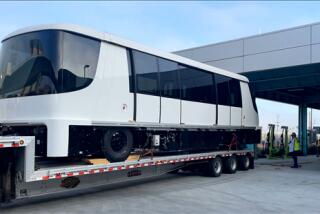For owner, end of the line
- Share via
All aboard! Allied Model Trains is leaving the station.
This week, one of the nation’s largest model train stores is closing its longtime home in Culver City: a half-block-long replica of Los Angeles’ Union Station. And fading along with it, says owner Allen Drucker, is the model train industry.
For the record:
12:00 a.m. May 25, 2007 For The Record
Los Angeles Times Friday May 25, 2007 Home Edition Main News Part A Page 2 National Desk 1 inches; 34 words Type of Material: Correction
Model Railroader magazine: A May 9 Business article on the Allied Model Trains store in Culver City reported the peak circulation of Model Railroader magazine as 272,000 in 1993. The correct figure is 224,000.
“It’s just a dying hobby,” said Drucker, 58. “We probably have another good 15 years.”
Drucker will hang up his cap after 32 years of running a miniature railroad hub. “I always told myself I didn’t want to be the old man running the train store,” he said.
New owners will move the business to a smaller Art Deco-style building Drucker owns across the street. He’ll rent the Union Station look-alike to Samy’s Camera.
With real estate values rising and competition from the Internet barking at his heels, he decided it was time to sell his business -- a favorite stop for West L.A. boys and girls and train buffs for generations. Among them were celebrities including Frank Sinatra, who had a building shaped like a train station at his Rancho Mirage estate.
“He had a huge Lionel layout and all along the walls were shelves full of trains,” said Drucker, who visited Sinatra’s home several times. “He had a real Santa Fe caboose too, as his workout room.”
Sinatra’s collection was acquired by Canadian business mogul Jim Pattison, along with Sinatra’s desert home. The crooner was one of several celebrity train collectors who shopped at Allied. Among Drucker’s other customers, he said, are music artists Rod Stewart and Bruce Springsteen and actor Donald Sutherland.
One of his longtime customers is former broadcaster and talk-show host Tom Snyder, who has loved trains all his life and has an elaborate setup at his Marin County home with Lionel trains from the 1920s and before.
“There’s magic to it,” Snyder said of the layout that passes through walls in his house. “It’s kept me going for a long time and now it’s a source of joy for my grandchildren.”
Model railroading dates to the early 20th century, when Lionel introduced its first electric-powered train. The business enjoyed a golden age during the 1920s, when heavy metal locomotives and cars were the most prized possessions of many boys.
After U.S. model train production stopped for World War II, the industry boomed again in the 1950s, when trains were the No. 1 toy for boys and were as pervasive in the culture as video games are today.
Video games are among the many competitors for children’s time and interest today, so the industry’s fan base is fading. Model Railroader magazine’s circulation has dropped to 162,000 from 272,000 in 1993, a spokeswoman said. Average railroaders, however, spend an estimated $1,555 a year on their hobby, almost twice as much as they did in the early 1990s.
Train buffs have always held ornate Union Station in downtown Los Angeles in high regard, dubbing it “the last of the nation’s great railway stations” after it was completed in 1939.
Drucker’s mini-Union Station on Sepulveda Boulevard was completed in 1989.
“I attribute a tremendous amount of our success to that building,” Drucker said. “It scaled down beautifully.”
But a notable building wasn’t enough.
“It has become increasingly more difficult to run a single store like mine in a major metropolitan area,” Drucker said. Among his challenges have been paying electric bills of $3,000 a month to help keep all his display trains running and maintaining a staff big enough to look after the place.
Then there is the looky-loo hobbyist who, he said, comes in, checks out the latest model trains with powerful lights and digital sounds but buys almost nothing.
“He says, ‘Wow, I would love that.’ Then he walks out of here with a tube of glue and a magazine and buys it online from some guy working out of a barn in the middle of Kansas. Folks like that are the first ones to scream, ‘I can’t believe you’re leaving.’ ”
But the real problem with the model train industry, Drucker said, is that its biggest fans are growing older. Many baby boomers still love electric trains, but they haven’t been able to pass along much of their passion to the next generations.
Customer Randy Miller endures gentle mockery from his children. “ ‘He’s 55 and still playing with trains,’ my daughter says. ‘I think he’s losing it.’ ”
Miller drove his pickup down from Simi Valley to check out Allied’s closing sale and walked out with $300 worth of Lionel boxcars in a big sack. He’s restoring his late father’s old train set and enjoying memories, recently using his skills as a machinist to restore a toy water tower his brother broke in the 1960s.
“My father never got over that,” Miller said. “Now it’s fixed.”
One hobbyist who is trying to encourage another generation of enthusiasts is Steve Lind, a retired Marine pilot and commercial banker who says he owns thousands of miniature train cars and is grateful that his wife, Nancy, “puts up with all my toys.”
He had his 4-year-old grandson, Ryan, in tow at Allied to look at some S-gauge rigs chugging effortlessly through a Lilliputian landscape.
“I’m getting him started on trains,” said Lind, who grew up in Chicago watching the Burlington railroad. “He’s going to inherit quite a few.”
Drucker’s love of trains also started early in his life. His father bought him an American Flyer set when he was 1 year old, which was set up around the family Christmas tree every year.
Drucker lost interest during his teen years but took up toy train collecting as a young adult and was hooked again. In 1975, when he was sick of his job at an electronics company, Drucker sold his house and car and bought Allied, a struggling West Los Angeles hobby shop founded soon after World War II.
Within a few years he had the business running strong again and kept expanding it. The 1980s were especially sweet.
“The whole nostalgia thing was in high gear and every yuppie on the Westside wanted a train around his Christmas tree,” he recalled.
Business is still good, he said, but Drucker recently learned that rising real estate values put him in a position to make a living as a landlord instead of a business operator. Taking over Allied at the new location will be one of his employees, Nick Barone, and former competitors Fred Hill and Brian Brooks of the Original Whistle Stop in Pasadena.
Hill said that the old Allied would be shuttered Saturday after its close-out sale was complete, and that he hoped to reopen the new store by July. The owners will keep Drucker’s emphasis on stocking toy trains, and the Original Whistle Stop will retain its focus on scale modeling, generally a more adult hobby in which participants often re-create specific railroads and locales in exacting detail.
“Allen’s was the fun store and ours was the serious store,” he said.
So although the fan base is aging, the hobby should always hold appeal for some grown-ups who want to escape the grinding uncertainties of life, said Brent Lambert of the National Model Railroad Assn.
“You can create your own little world you can get away to,” he said, “where things are exactly the way you want them to be.”
More to Read
Inside the business of entertainment
The Wide Shot brings you news, analysis and insights on everything from streaming wars to production — and what it all means for the future.
You may occasionally receive promotional content from the Los Angeles Times.











